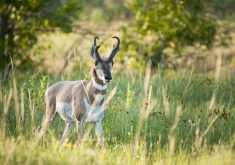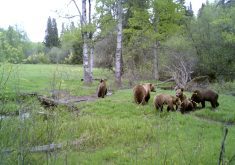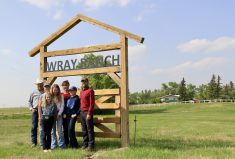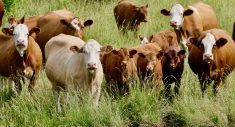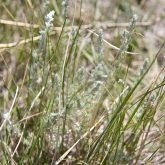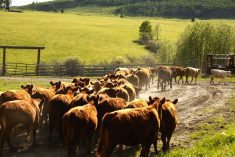The Hagan families of Virden, Man., were pleasantly surprised this summer to hear that they had not only been nominated by Manitoba Habitat Heritage Corporation for the prestigious National Blue-winged Teal Award, but had been chosen by the North American Waterfowl Management Plan Committee as this year’s recipient.
The award is presented annually through Environment Canada and the U.S. Fish and Wildlife Service to Canadian, American and Mexican individuals, government officials and departments, non-governmental organizations, corporations, partnerships, programs or donors of land, services or cash that have been of regional or national significance to waterfowl, migratory birds, wetlands and other habitats.
Read Also

Body condition, nutrition and vaccination for brood cows
One of the remarkable events of the past century related to ranching has been the genetic evolution of brood cows….
The Hagans are unique among the list of past recipients because this is the first time the award has gone to a family, says MHHC CEO Tim Sopuck.
“The conservation easements stand out as to the commitment the family has made, but more than the easements is the family’s conservation ethics. The award tends to go to individuals and organizations, but in this case, we have a family of ranchers who are walking the talk,” he says.
The Hagans have been working with MHHC since 2003 and now have nearly 4,900 acres of private natural land protected by 15 conservation easements, by far the largest number of easements established by a farm family in Manitoba.
“Cattle producers are very important clients for us because we view raising cattle on native range and hayland as very important elements of wildlife habitat conservation in Western Canada. We welcome every opportunity to work with and applaud the beef industry’s efforts to conserve (grassland, woodland and wetland) habitat for wildlife. Good range management is good habitat management — they just fit together,” says Sopuck.
That’s exactly what Thomas and Felicity Hagan have seen on their ranch bordering Oak Lake where there are waterfowl and wildlife aplenty.
“We calve in June and put a ton of focus on soil health, grazing techniques and genetics in the cows to fit that program. Conservation is really a byproduct of what we do because if we are benefiting our cows, we are benefiting the birds, insects and wildlife,” Thomas says.

Alistair and Erin Hagan view conservation easements as a two-way street. The agreement with MHHC supports conservation, while the one-time payment received from MHHC for each conservation easement has helped their parents, Shawne and Jocelyn, and now the brothers’ families build their ranches.
The Hagans have taken a road less traveled to expansion with each couple stepping out to make significant purchases of land and operate independently rather than adding onto their parents’ ranch. The families work together on the annual Hagan Performance and Ranch Horse Sale each October and when one needs extra hands, but it’s each family to its own when it comes to the business decisions, management strategies and financials.
Alistair says conservation easements would be equally as useful for intergenerational transfers, enabling the younger generation to make a lump sum payment to the parents for a start on their retirement.
An easement doesn’t need to cover large blocks of land, he adds. While the Hagan ranches do have a large tract of native grassland pasture protected corner to corner, most of the easements are on much smaller parcels with natural wetlands, potholes and low-lying hayland.
Conservation easements are legal agreements with a lifetime caveat placed on the land so they are careful not to blindly put them on land that might have better use someday, he explains.
Land committed to conservation easements has to remain intact in that it can’t be drained, bulldozed or cultivated, but MHHC doesn’t place grazing or haying limitations on the easements or interfere in any way with day-to-day ranching activities. Nor does MHHC stand in the way of potential mining or oil development activities that offer ranchers and farmers the opportunity to earn income from leases. In that situation, MHHC works with the development company to trade land for conservation.
Vertically stacked and open for business
Their grass-based cow-calf and yearling operation, led into custom grazing and a newly added direct-marketing business, while their horse breeding and training programs supply the horses they rely on for everyday ranch work before they ever make the cut for the family horse sale.
“Our dad had a strong influence on us to do our own thing because he followed his own dream of creating a ranch and cowboy lifestyle. We are very interested in what each other is doing, but we are okay with everyone not doing the same thing,” Alistair says.
Being the eldest sibling, he well remembers the evolution of their parents’ farm from a mixed grain and purebred Charolais operation with winter calving in the barn, to a ranch with 600 commercial cows. They now consider themselves to be semi-retired with 220 black and red cows calving in spring and a yearling operation.
Alistair’s family resides on the original Hagan farmstead where they have built up a 1,000-head custom grazing operation in a managed rotational system on tame forage land, while their herd of 250 cows is managed in a slow rotation on the native pasture near Oak Lake.
The year starts with weaning calves in March and the cows grazing some of the 40-acre custom paddocks from early April until early May, when they are trailed the nine miles to summer pasture to begin another calving season. The weaned calves stay in the custom paddocks and are sold in fall at the local auction market or directly to feedlots paying for natural calves.
Back at home in late fall, the new pairs graze crop residue and brushy wetland areas across from the home place on three-quarters of land they rent to a local grain farmer. The herd winters most often on bale grazing, but they have used swath and corn grazing as well. With harvest generally being earlier nowadays, they are working with the renter to figure out a way to incorporate fall cover-crop grazing.
This summer proved to be interesting from a rotational grazing perspective because of the lack of rain in contrast to flooding a couple of years ago. Compared to their hayland that yielded about 60 per cent of what they’d normally bale up, they had tremendous grass in the custom grazing paddocks. This he attributes to the quick three- to five-day rotation, giving each paddock lots of rest between grazings. Some paddocks lagged behind, though, and a look back through his nine years of grazing records showed why. They were paddocks where cattle had been left to graze for longer than usual during busy times in past years.
Alistair also manages the Wallace municipal pasture where his dad is the right-hand man, giving them lots of opportunity to put extra time on developing reliable, safe horses for sale customers. Erin and their children, Harley-Mae and Slade, put their fair share of time in the saddle working with cattle on the ranch and competing at local events, as do Thomas and Felicity, who buy and train horses for the sale.
Alongside the horse sale, Thomas and Felicity’s main enterprises are a 250-head cow-calf and yearling operation and their new grass-fed beef business. Custom grazing 200 pairs is helping them move toward their goal of eventually having 400 cows of their own to fit their native grassland base of 3,200 acres, all of which is covered by a conservation easement.
This summer they launched their own brand, Naturally Manitoba, to sell grass-fed beef directly to customers.
Renard Meats, a provincially licenced plant right in their home town, handles the processing.
“We’ve been preparing for this for quite a while. It’s not that we have anything against grain-finished beef but we need to do the most with our grass as we can so we have been doing a grass-fed program anyway,” Thomas explains.
They move the fence every one to five days from early spring through late fall to keep fresh grass in front of the pairs and have noted the improvement in soil health and cow health.
The overall goal is to maintain vegetative, high-energy (carbohydrate) grass by allowing the cattle to graze only the top third of the plants. The rest period between grazings varies from parcel to parcel.
The big bonus has been the improved productivity and quality of the lowland native grasses, particularly the species, Redtop, he says. Cattle typically avoid it because it gets coarse and seedy in a hurry, but managing one-day moves through it at the right times to clip off the tops keeps the plants vegetative. In this way they have been able to graze these areas three or four times a year at high-density stocking rates.
The calves stay on the cows for the winter, bale grazing quality purchased hay in three-week paddocks. Adding the grass-fed beef sales was just a matter of carrying their open yearling heifers over the winter and grazing them for the summer to put on the finishing fat layer.
The final product has been scrutinized by the butcher, the government inspector and many friends and relatives who give it two thumbs up for taste and tenderness.
The dos and don’ts of marketing learned from 10 years of horse sales gives them a head start on that end of the business, but they have every confidence that their product will sell itself. They firmly believe that beef is poised and ready to fill the demand for healthful fats to replace the overabundance of carbohydrates as an energy source.
For more information, visit the Hagan Ranch website.




